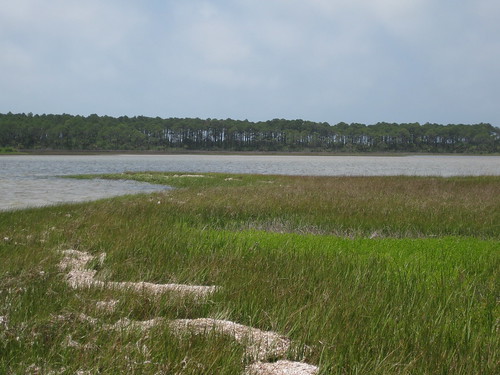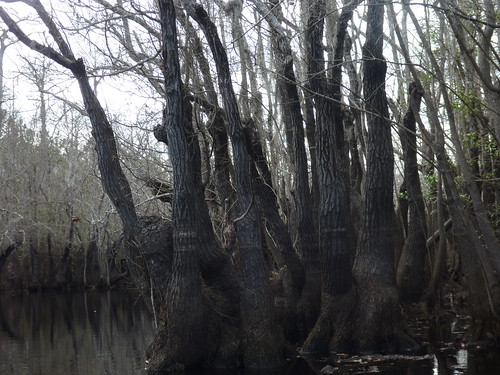Rob Diaz de Villegas WFSU-TV
Tune into WFSU-TV’s dimensions on Wednesday, February 15 at 7:30 PM/ ET to watch our paddling and wildlife watching EcoAdventure throughout the Apalachicola River system.
[iframe http://imapflickr.com/f6b558 542 461]
Zoom into the clusters of flags to see each site in more detail.

This marsh island might be comprised of several genetically distinct cordgrass individuals, or just a few.

 In composing and researching this post, I seem to have stumbled upon a diversity of biodiversity. In Randall Hughes’ salt marsh biodiversity study, you don’t always even physically see it. Within a salt marsh, you might be looking at a variety of cordgrass individuals, or just one. You wouldn’t know until you got the DNA results back from the lab. That’s genetic diversity, the variation of genes within a species. A little more obvious is the diversity of plant and animal life within a habitat: what other plants are mixed in with the cordgrass, what different predators are eating and terrorizing periwinkle snails, etc. This species diversity is also crucial to a system’s health, and to the services it provides us.
In composing and researching this post, I seem to have stumbled upon a diversity of biodiversity. In Randall Hughes’ salt marsh biodiversity study, you don’t always even physically see it. Within a salt marsh, you might be looking at a variety of cordgrass individuals, or just one. You wouldn’t know until you got the DNA results back from the lab. That’s genetic diversity, the variation of genes within a species. A little more obvious is the diversity of plant and animal life within a habitat: what other plants are mixed in with the cordgrass, what different predators are eating and terrorizing periwinkle snails, etc. This species diversity is also crucial to a system’s health, and to the services it provides us.

In the spring, these dwarf cypress trees will be green and lush, but in the winter, they add an appropriate ambience to a place named Tate's Hell. The lines on the tree indicate that the water is below the usual level, a result of low rainfall of late.
When I went to visit several spots along the Apalachicola River System last month, I got a dose of region-wide ecosystem diversity. You most definitely can see that. That day, we hit five spots within about twenty miles (see map above). We shot video in freshwater marshes, pine flatwoods, and- my personal favorite- a cypress swamp. Further out into Apalachicola Bay are salt marshes, oyster reefs, and seagrass beds. All of these systems in close proximity, sitting on extensive stretches of protected land, make the Apalachicola River Basin one of the most biodiverse places in our country. These are productive systems, producing everything from renowned Tupelo honey and oysters to the third largest shrimp harvest in Florida.
A large group of individuals within a single species means a greater variety of genes is available to help that species adapt to different situations. Say there was an extreme weather event- multiple days of sub-zero temperatures, for example. If a marsh has a large group of cordgrass individuals, there is a greater likelihood that cold resistance genes would be present, and so the marsh is likelier to survive. As Randall’s snail experiment showed, a diversity of different species at a single site can be beneficial as well. Looking at the productivity and richness of species in the Apalachicola River Basin, a diversity of ecosystems would appear to be similarly advantageous. At the very least, it makes for a great place to visit. You could spend days exploring the area, hopping from habitat to habitat. Our guides would be ecstatic if you did.
Liz Sparks and Andy Wraithmell work for the Florida Fish and Wildlife Conservation Commission (FWC). Liz wanted to show me some spots in the Apalachicola River Paddling Trail System. Andy took us to some spots on Great Florida Birding and Wildlife Trail. The varied ecosystems of the Apalachicola provide a wealth of scenery and a home to many rare plants and animals. Animal life in the basin includes the biggest diversity of reptiles and amphibians in North America (North of Mexico) and many rare birds, like the Red Cockaded Woodpecker. If you’re there early enough, you might even see a black bear.
Next week’s dimensions segment takes us on a whirlwind excursion to the freshwater marshes of Sand Beach and Cash Creek, the cypress swamp Graham Creek (in Tate’s Hell), and Bloody Bluff, which is right alongside the Apalachicola River. There might be a shot or two in there from Whiskey George Creek (diversity of awesome location names doesn’t guarantee an excellent adventure, but it can enhance one). On the blog, we’ll look at the wildlife management used to keep the river system healthy, in particular prescribed burning in the longleaf pine/ wiregrass ecosystem.

